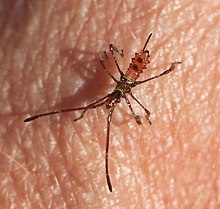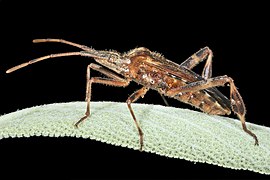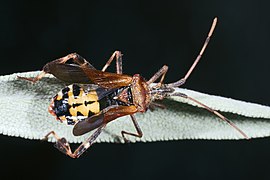American pine bug
| American pine bug | ||||||||||||
|---|---|---|---|---|---|---|---|---|---|---|---|---|

American pine bug ( Leptoglossus occidentalis ) |
||||||||||||
| Systematics | ||||||||||||
|
||||||||||||
| Scientific name | ||||||||||||
| Leptoglossus occidentalis | ||||||||||||
| ( Heidemann , 1910) |
The American pine or cone bug ( Leptoglossus occidentalis ) is a bug from the family of the edge bugs (Coreidae). The original range of the species covers the west of North America west of the Rocky Mountains . The species has spread its range in North America since the mid-1950s as far as the east coast of the USA, again through introduction, the species was first detected in Europe in 1999 and has since spread as a neozoon over large parts of Europe.
In plantations for the production of coniferous seeds, the species causes yield reductions by sucking on the cones . Therefore, it is classified as a pest in the United States. However, no other economically relevant harmful effects are known from either North America or Europe.
description
American pine bugs are comparatively large and showy bugs. The animals equipped with long antennae have a body length of 15 to 20 millimeters and are 5 to 7 millimeters wide. The tibiae of the hind legs are noticeably widened. The upper side is reddish brown to black, in the middle of the elytra runs a characteristic, narrow white zigzag band, but this can also be weak or absent. The upper side of the abdomen shows, only visible in flight and otherwise hidden by the wings, on an orange or yellow background five black transverse bands.
The animals are good fliers, they fly and the loud humming resembles the flight of bumblebees . In the case of major disturbances, they can secrete a secretion, the smell of which, according to W. Cranshaw, is somewhat reminiscent of pine needles, and according to B. Perny, rather pleasantly reminiscent of apples.
Possible confusion
In Europe, the American pine bug cannot be confused with the native species. In North America, it can be confused with the American pine needle bug ( Leptoglossus corculus ). This, however, has a darker, almost black abdomen and the leaf-like widenings of the tibia are asymmetrical.
distribution
The original range of the species covers the west of North America west of the Rocky Mountains from the Canadian province of British Columbia to Mexico. Presumably through displacement, the species was first discovered in 1956 far east of the Rocky Mountains in the state of Iowa , from there it spread quickly and reached the east coast of the USA in 1990 in the state of New York . The distribution of L. occidentalis now extends northeast to the Canadian province of New Brunswick .
In Europe, the American pine bug was first reported in northern Italy in 1999. How the species got there from North America is not known; Imports of Christmas trees, seeds or building materials are considered possible routes of introduction. Since then it has spread over large parts of Europe through its own spread and other unintentional introductions. The species reached Switzerland in 2002, Slovenia and Spain in 2003, Croatia and Hungary in 2004, Austria in 2005, France and Germany in 2006, the Czech Republic, Poland, Belgium and Great Britain in 2007, Slovakia and Bulgaria in 2008, Denmark and Norway in 2009, and Ukraine in 2011. It was also L. occidentalis , 2008 in Tokyo demonstrated.
In autumn 2018, the American pine bug appeared in large numbers in Germany after a hot summer that was favorable for its reproduction. In search of warm places, it also penetrated apartments, which some people saw as an "invasion".
Way of life
In most of its range, L. occidentalis forms only one generation per year ( univoltin ), only in Mexico several generations are formed per year. The species is polyphagous , the adults suckle on the young seeds and flowers of conifers , especially on pine ( Pinus spp.), But also on Douglas fir ( Pseudotsuga menziesii ), white spruce ( Picea glauca ) and other species. The species is very adaptable and also sucks in newly populated areas on the conifer species that occur there, in North America for example also on the black pine ( Pinus nigra ) imported from Europe . In captivity the animals also suckled on the fruits of the pistachio ( Pistacia vera ).
The eggs are laid mainly after wintering from the end of May or the beginning of June. The females lay up to 80 cylindrical eggs about 2 mm long in rows on the needles of the host plants. The nymphs hatch after 10 to 14 days. The first nymph stage sucks on needles and the water-storing tissue of the cones, the further nymph stages suck on the seeds. The animals go through five nymph stages and molt to the imago around August, which overwinters. Protected areas such as raptor nests, rodent nests , hollow spaces under tree bark or buildings are sought out for wintering . Males give off an aggregation pheromone , which can lead to large gatherings of up to 2000 animals in winter roosts.
In America, only about 10% of the eggs laid make adults. Important regulators of bugs populations are there beside predators also Eiparasitoide , especially the Hymenoptera Gryon pennsylvanicum from the family Scelionidae . In Italy, a parasitized by the wasp Anastatus bifasciatus (Family Eupelmidae ), a native to Europe egg parasitoids found.
American pine bug and human
When harvesting conifer seeds, the species causes reduced yields by sucking on the cones and is therefore classified as a pest in the USA. The seeds remain externally intact, but show up as empty or only partially filled on X-rays. Estimates of seed losses caused by American pine bugs are inaccurate; for the Douglas fir they range from less than 5% to 50%. However, there is no direct damage to the seed trees. No other economically relevant harmful effects are known from either North America or Europe.
In the USA, the species is also regarded as a " nuisance " due to the occasional massive autumn influx into apartments and houses , but the animals are completely harmless.
literature
- JE McPherson, RJ Packauskas, SJ Taylor, MF O'Brien: Eastern range extension of Leptoglossus occidentalis with a key to Leptoglossus species of America North of Mexico (Heteroptera: Coreidae). In: The Great Lakes Entomologist. 23, No. 2, 1990, pp. 99-103. ( Online, PDF )
- W. Rabitsch, E. Heiss: Leptoglossus occidentalis HEIDEMANN, 1910, an American adventitious species also found in Austria. In: Reports of the Natural Science-Medical Association in Innsbruck. Volume 92, Dec. 2005, pp. 131-135. ( Online, PDF )
- E. Wachmann , A. Melber & J. Deckert (2007), Bugs 3 - Tierw. Deutschlds., 78, pp. 206-207, ISBN 978-3-937783-29-1
Individual evidence
- ↑ a b c d e f g h i Wolfgang Rabitsch, Ernst Heiss: Leptoglossus occidentalis HEIDEMANN, 1910, an American adventurous species also found in Austria. In: Reports of the Natural Science-Medical Association in Innsbruck. Volume 92, Dec. 2005, pp. 131-135. ( Online, PDF )
- ^ A b Steve Jacobs Western: Conifer Seed Bug - Leptoglossus occidentalis. Pennsylvania State University, Department of Entomology 2010 (online, accessed November 9, 2010)
- ^ WS Cranshaw: Conifer Seed Bugs. No. 5,588, Colorado State University Extension 2/99. Revised 11/06. ( Online, accessed November 13, 2010 )
- ^ Whitney Cranshaw: Garden insects of North America: the ultimate guide to backyard bugs. Princeton University Press, 2004, ISBN 0-691-09561-2 , p. 232.
- ↑ a b Bernhard Perny: Extraordinary insect occurrence recently. In: Forstschutz Aktuell. 45, 2008 ( Online ; PDF; 243 kB)
- ^ A b c d François Dusoulier, Roland Lupoli, Henri-Pierre Aberlenc, Jean-Claude Streito: The eastern invasion of Leptoglossus occidentalis (Coreidae) in France, 2007. In: Het News. 12, 2008: pp. 10-12. Online as PDF (English translation of the French article, original published in: L'Entomologiste. 63, 6, 2007, pp. 303–308.)
- ^ SJ Taylor, G. Tescari, M. Villa: A Nearctic pest of Pinaceae accidentally introduced into Europe: Leptoglossus occidentalis (Heteroptera: Coreidae) in northern Italy. In: Ent. News. 112 issue 2, 2001, pp. 101-103 ( online as PDF )
- ↑ a b Jerzy A. Lis, Barbara Lis, Jerzy Gubernator: Will the invasive western conifer seed bug "Leptoglossus occidentalis" Heidemann (Hemiptera: Heteroptera: Coreidae) seize all of Europe? In. Zootaxa 1740, 2008, pp. 66-68.
- ^ Marek Barta: New facts about distribution and host spectrum of the invasive nearctic conifer pest, Leptoglossus ccidentalis (Heteroptera: Coreidae) in south-western Slovakia. Folia faunistica Slovaca, 2009, 14 (23), pp. 139–142. ( Online ( page no longer available , search in web archives ) Info: The link was automatically marked as defective. Please check the link according to the instructions and then remove this notice . ; PDF; 207 kB)
- ↑ Nikolay Simov: Western conifer seed bug Leptoglossus occidentalis Heidemann, 1910 (Heteroptera: Coreidae) already in Bulgaria. In: Historia naturalis bulgarica. 19, 2008, pp. 179–180, ( Online ( Memento of the original from August 26, 2016 in the Internet Archive ) Info: The archive link has been inserted automatically and has not yet been checked. Please check the original and archive link according to the instructions and then remove this notice . ; PDF; 581 kB)
- ↑ Mjøs, AT, Nielsen, TR & Ødegaard, F .: The Western Conifer Seed Bug (Leptoglossus occidentalis Heidemann, 1910) (Hemiptera, Coreidae) found in SW Norway. In: Norw. J. Entomol. 57, 2010: pp. 20-22. ( Online, PDF; 617 kB ).
- ↑ Putshkov, PV, Gubin, AI, Popov, GV, Kalesnik, VI & Syzhko, VV: The North American intruder Leptoglossus occidentalis Heidemann (Heteroptera: Coreidae) settled down in Ukraine. Ukrainska Entomofaunistyka 3 (3), 1-3 ( Online as PDF )
- ↑ T. Ishikawa, Y. Kikuhara: "Leptoglossus occidentalis" Heidemann (Hemiptera: Coreidae), a presumable recent invader to Japan. In: Japanese Journal of Entomology (New Series). 12 (3) 2009, pp. 115-116.
- ↑ Stuttgarter Zeitung : Bugs in Stuttgart - Expert explains where the many bugs come from October 18, 2018, accessed on October 20, 2018.
- ^ Pforzheimer Zeitung : Readers question: Regular invasion - What kind of crawling animals are they? October 18, 2018, accessed October 20, 2018.
- ↑ a b c d J. E. McPherson, RJ Packauskas, SJ Taylor, MF O'Brien: Eastern range extension of Leptoglossus occidentalis with a key to Leptoglossus species of America North of Mexico (Heteroptera: Coreidae). In: The Great Lakes Entomologist. 23, No. 2, 1990, pp. 99-103.
- ↑ Beat Wermelinger: The American pine bug . In: Federal Research Institute WSL, Birmensdorf (Ed.): G'plus the gardener magazine . January 2011, p. 45 ( [1] [PDF]).
- ^ Sarah L. Bates, Cameron G. Lait, John H. Borden, Allison R. Kermode: Effect of feeding by the western conifer seed bug, Leptoglossus occidentalis, on the major storage reserves of developing seeds and on seedling vigor of Douglas-fir . In: Tree Physiology 21, 2001: pp. 481–487 ( Online ; PDF; 273 kB)
Web links
- Stages of metamorphosis (English)
- Status of L. occidentalis in Britain (English)
- Leaflet from the Pest Control Advice Center of the City of Zurich: The American cone bug , PDF file, 147 kB





